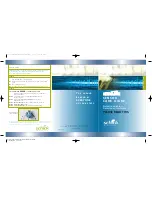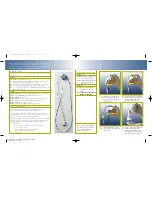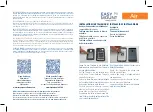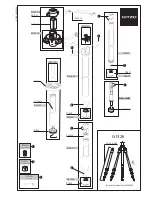
S E N S O R C A R E
T
O PREVENT DAMAGE TO YOUR SENSOR
(
S
),
PLEASE READ AND FOLLOW THESE
SUGGESTIONS
:
PLEASE
DO
disinfect sensor prior to each use.
DO
wipe down the sensor with a disinfectant. For best results use an
ethanol (80%) based product (such as Lysol).
DO
store the sensor in its holster (PN B1070025) when it is not in use.
DO
keep the sensor and the remote off of the floor at all times.
DO
use only Schick Technologies positioning products and sheaths every
time the sensor is used.
PLEASE
DON’T clamp
the sensor or its cable with a hemostat or equivalent.
DON'T
use a
Snap-a-Ray
holder with CDR Elite Sensors.
DON’T autoclave
the sensor.
DON’T soak
the sensor or its connector in disinfecting solution.
DON’T pull
the sensor by its cable during sheath removal.
DON’T hang
the sensor by its cable.
DON’T
allow anyone to
bite
on the sensor or cable.
S TAT I C P R E V E N T I O N
Static electricity is a potential source of problems with electronic
devices, particularly computers and their peripherals.
Your Schick CDR system is no exception. As such, basic precautions
should be taken to prevent static build-up,
especially if you are using the
system in a carpeted room and/or areas of low humidity.
If you feel that static may be present in the areas where you will be using
your CDR system, the following suggestions will help eliminate static
build-up and protect your computers, CDR equipment, and other
electronic devices:
• Ensure your electrical outlets are properly grounded
• Anti-static floor mats
• Floor treatments (i.e. Staticide 2005/2002)
• Air Humidifier (humidity of 50+%)
• Air Ionizer
SHEATH REMOVAL GUIDE
PLEASE
DON'T
pull on the cable when
removing the sheath.
DON'T
start by pulling the sheath
off the aiming bar and
adhesive.
PLEASE
DO
always be gentle with the
cable while removing the
sheath.
DO
FOLLOW THE 4 STEPS IN THE
IMAGES TO THE RIGHT.
Store sensor in holster with wire
looped loosly over the holster
once to prevent kinking as
illustrated to the left.
CDR
®
E
LITE SENSORS ARE DESIGNED AND TESTED TO WITHSTAND YEARS OF
NORMAL DAILY USE
. I
N FACT
,
THE MOST COMMON REASON FOR SENSOR
FAILURE IS EXCESSIVE FORCE APPLIED TO THE SENSOR BODY AND
/
OR CABLE
.
T
HIS T YPE OF DAMAGE IS NOT COVERED BY WARRANT Y
.
Keeping the sensor attached to
the positioning tab and aiming
bar, grasp the aiming bar where
it joins the sensor.
1.
Still grasping the bar underneath
the sheath, with your thumb, start
pushing the distal tip of the
sensor out of the sheath.
2.
Continue pushing the sensor
away from the closed, tight end
of the sheath.
3.
As the sensor is pushed into the
wider area of the sheath, be
careful to prevent the sensor
from falling on the floor. Handle
both sensor and cable gently.
4.
SensorCareGuide CMYK:SensorCareGuide.1 2/25/09 4:52 PM Page 2
Printed copies of this document are considered uncontrolled.
11652.1.Rev001 04.21.2015




















